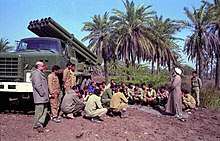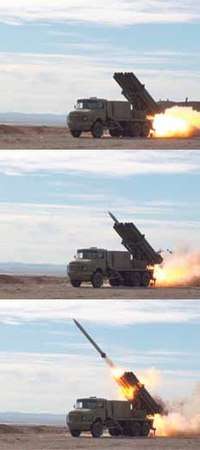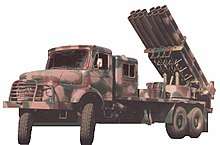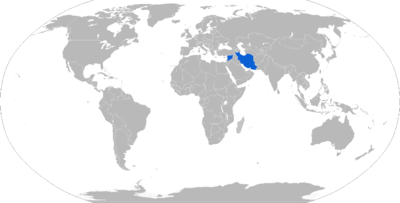Fajr-3
| Fajr-3 | |
|---|---|
.jpg) A Fajr-3 in 2018. | |
| Type | Rocket artillery |
| Place of origin | Iran |
| Service history | |
| In service | 1996–present |
| Used by |
Iran Syria |
| Wars | 2006 Lebanon War |
| Production history | |
| Manufacturer | Shahid Bagheri Industrial Group[1] |
| Produced | November 6, 1996 |
| Specifications | |
| Weight |
15,000 kg (System) 45 kg (HE Content) 90 kg (Warhead) 407 kg (Rocket) |
| Length |
10.45 m (Launcher)[2] 5,200 mm (Rocket) |
| Width | 2.54 m (Launcher)[2] |
| Height | 3.34 m (Launcher)[2] |
| Diameter | 240mm |
|
| |
| Caliber | 240 mm |
| Elevation | 0 to 57 degrees[2] |
| Traverse | 90 degrees left/100 degrees right[2] |
| Rate of fire |
4–8 seconds[2] 12 rounds in 48 seconds (est)[3] |
| Muzzle velocity | ? |
| Maximum firing range | 43 km[2] |
|
| |
| Engine | 280 hp, V-8 liquid-cooled, diesel engine[3] |
| Speed |
60 km/h (road) 25 km/h (off-road)[3] |
The Fajr-3 (rarely Fadjr-3) (Persian: فجر-۳) is an Iranian heavy 240 mm intermediate-range[4] multiple-launch artillery rocket (MLRS).[3] The Fajr-3 is a license-built copy, with slight modifications, of a North Korean MLRS called the M-1985.[5] The Fajr-3 was introduced in the 1990s and has since been exported to Syria, Hamas and Hezbollah.
The Fajr-3 launcher fires twelve 5.2 meter long, 240 millimeter-calibre Fajr-3 artillery rockets, with an estimated range of 43 kilometres, weighing 407 kilograms each and carrying 45-kilogram HE warheads.[3] Fajr means 'dawn' in Arabic.
History

During the Iran–Iraq War, around a dozen North Korean M-1985 MLRS systems were exported to Iran.[6] The North Korean M-1985 was derived from Soviet Katyushas, and so the Fajr-3 is sometimes considered a Katyusha too.[7] With North Korean assistance, Iran's state-run Shahid Bagheri Industries started to domestically develop the system in March 1990[8][9] under license.[5] Analysts in Abu Dhabi learned about the development less than a month later and described it as "one of the most important new weapons" under development in Iran.[10] The development program for the Fajr-3 might have been run in conjunction with the development of the Oghab.[5]

The first Fajr-3s were produced either in 1990 or on November 6, 1996,[11] (sources differ) and the system entered service that year.[3] Early versions of the Fajr-3 apparently had reduced range and it was not until December 1998 that Iran tested a rocket with the full 43 km range.[12] Fajr-3 rockets are known to have still been in production in 2006.[13]
Description

The Fajr-3 launcher has twelve tubes in two groups of six.[2] The system was first installed on a Mercedes-Benz 2624 series chassis, has since been seen with Japanese Isuzu chassis, and is currently used on Mercedes-Benz 2631 chassis.[14] Apart from the chassis differences, which are trivial, there are no Fajr-3 variants.[3] The launcher is unarmored, weighs 15 metric tons, and has no fire-control system.[3] The rocket is solid fueled[5] and has a fragmentation high explosive warhead.[3] A complete Fajr-3 system is manned by a crew of five and also includes one dedicated resupply vehicle with a crane.[3] A reload is estimated to take 12-15 minutes.[3]
Combat use
The Fajr-3 is used by the Iranian and Syrian armies as rocket artillery. In 2010 Iran used the Fajr-3 in an exercise.[15] The Fajr-3 is likely to be in Iran's inventory for decades.[16]
2006 Lebanon War
Fajr-3 MRLS were supplied to Hezbollah in Lebanon in the early 2000s (possibly 2002[17]) and used in small numbers in the 2006 Lebanon War.[18] The Israeli Air Force identified the Fajr-3, along with other long- and medium-range artillery rockets, as their main target in the war, and attempted to destroy them in a large attack in the beginning of the war.[19] Similarly, Hezbollah viewed their Fajr-3 systems and similar rockets as their "centerpiece for operational planning" in the lead-up to the war.[19]
At least some of Hezbollah's Fajr-3 rockets survived Israel's initial wave of airstrikes, and "tens" were fired sporadically at Israel over the course of the war, mainly targeting the Israeli city of Haifa.[20] The rocket's long range meant that they were mostly deployed from north of the Litani River.[20] Hezbollah's Fajr-3 MLRS were mobile and were reportedly controlled from a Hezbollah headquarters in Tyre.[20]
Iraq
A Fajr-3 rocket was fired by unidentified Iraqi insurgents on September 11, 2007, and injured an American soldier in Baghdad.[13]
Operators

Current operators
References
- ↑ Shahid Hemmat Industrial Group. Archived 2008-06-27 at the Wayback Machine. Retrieved on May 13, 2008.
- 1 2 3 4 5 6 7 8 Fajr-3 & Fajr-5 brochure. Retrieved on May 13, 2008.
- 1 2 3 4 5 6 7 8 9 10 11 "Worldwide Equipment Guide 2015: Ground Systems" (PDF). 2015. p. 412–413.
- ↑ Johnson, David E., Hard Fighting: Israel in Lebanon and Gaza. Santa Monica, CA: RAND Corporation, 2011. p. 51. https://www.rand.org/pubs/monographs/MG1085.html. Also available in print form.
- 1 2 3 4 Iran's Ballistic Missile Capabilities: A Net Assessment. The International Institute for Strategic Studies. 2010.
- ↑ Iran Profile: Missile Capabilities—Long-Range Artillery Rocket Programs at NTI
- 1 2 Christopher Harmer (August 16, 2012). "Threat and Response: Israeli Missile Defense" (PDF). Institute for the Study of War.
- ↑ "Military Briefing on Hezbollah's Missile Capabilities: Examining the Fajr, Zelzal". Vital Perspective. 2006. Retrieved 2006-08-02.
In the late 1980s, the North Korean-produced 240 mm M-1985 multiple rocket launcher (MRL) was exported to Iran and subsequently produced under license (with minor changes) by Shahid Bagheri Industries as the Fajr-3 (a.k.a., Fadjr-3).
- ↑ FADJR-3. Archived 2008-05-10 at the Wayback Machine. Retrieved on May 12, 2008
- ↑ "JPRS Report, Arms Control". 3 May 1990.
- ↑ Missile Chronology, 1996. Archived 2010-03-08 at the Wayback Machine. Retrieved on May 12, 2008.
- ↑ Anthony H. Cordesman, with assistance from G. Ryan Faith (April 2003) The Military Balance in the Middle East: An Analytic Overview: Military Expenditures and Arms Transfers, Major Arms by Country and Zone, and Qualitative Trends
- 1 2 Major Brian H. Cunningham (2009). "Islamic Revolutionary Guard Corps: Instability in the Middle East" (PDF).
- ↑ "Fadjr-3 Fajr-3 RAAD 240mm multiple rocket launcher system technical data sheet specifications". www.armyrecognition.com.
- ↑ "Test-firing of Fajr 3 and 5 rocket launchers". Mehr News. 26 April 2010.
- ↑ Robbin Finley, Future Ground Requirements: 2012 and Beyond (23 March 2012) http://www.dtic.mil/dtic/tr/fulltext/u2/a559642.pdf
- ↑ Cragin, Kim, Peter Chalk, Sara A. Daly, and Brian A. Jackson, Sharing the Dragon's Teeth: Terrorist Groups and the Exchange of New Technologies. Santa Monica, CA: RAND Corporation, 2007. https://www.rand.org/pubs/monographs/MG485.html. Also available in print form.
- ↑ Ove Dullum, The Rocket Artillery Reference Book. Norwegian Defence Research Establishment (FFI). 30 June 2010. ISBN 978-82-464-1829-2
- 1 2 MAJ Brad R. Henry, "Manufacturing the Horns of Dilemma: A Theory of Operational Initiative." April 13, 2015. School of Advanced Military Studies, United States Army Command and General Staff College, Fort Leavenworth, Kansas. http://www.dtic.mil/dtic/tr/fulltext/u2/1007877.pdf
- 1 2 3 William M. Arkin, Divining Victory: Airpower in the 2006 Israel-Hezbollah War (2007) ISBN 978-1585661688
- ↑ International Institute for Strategic Studies (IISS) (14 February 2018). "The Military Balance 2018". The Military Balance. Routledge. 118: 334.
- ↑ http://thearkenstone.blogspot.com/2014/03/mystery-facility-north-of-bandar-abbas.html
- ↑ "Estimates for Hezbollah's Arsenal". Critical Threats.
- ↑ Anthony H. Cordesman, Iran's Rocket and Missile Forces and Strategic Options. October 7 2014. p. 60.